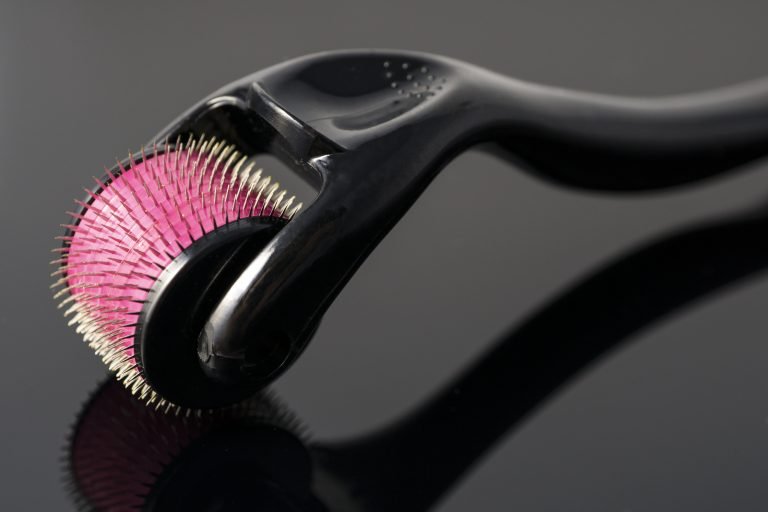
Page Contents
At some point when you are noticeably losing your hair, you are likely going to find yourself feeling self-conscious.
More than that, obviously thin patches on your head can make you feel unattractive. This is the reason behind the so many widely different hair treatment products and methods out there.
One method for hair loss that you have possibly heard about is derma rollers. This is a hair loss treatment that only takes a simple tool and about 10 to 15 minutes of your time.
What A Derma Roller Is
A derma roller is a small metal or plastic tool with a handle that is about the same size as the handle of a shaver.
Instead of having a razor at the other end, however, there is a small roller. This small roller is perfectly round and is covered on all sides with tiny micro-needles.
Whatever the handle may be made of, these needles are usually made out of titanium. As you roll a derma roller across your skin, these tiny needles leave equally tiny puncture marks in your skin. This treatment is used for a wide variety of different things.
While derma rolling can be used on your scalp to help with your hair growth, derma rolling can also be used elsewhere on your body. Partially for this reason, there are derma rollers of various sizes.
The size is indicated by a number either on the derma roller itself or on whatever package the roller comes in.
This number indicated the size of the needles on the roller, which is the most important part of a derma roller.
There are over half a dozen different size options when it comes to derma rollers. The most common sizes are: 0.15 mm, 0.25 mm, 0.5 mm, 0.75 mm, 1.0 mm, 1.5 mm, 2.0 mm, and 3.0 mm.
However, the largest two sizes are not safe for use on your scalp or the sensitive skin of your face.
It is debatable if you should even use the 1.5 mm size on your scalp.
Finally, the needle count can vary too, with the more common derma rollers having between 90 to 540 needles.
Why A Derma Roller Can Benefit Your Hair
The whole purpose of the needles of a derma roller is to make tiny pinpricks into your skin.
These pricks are meant to just barely penetrate into the dermis layer of your skin. This is the right depth needed to stimulate the production of new cells and boost the circulation to that area.
At the same time, these derma needles do not penetrate too deeply into the skin so as to cause damage.
While using a derma roller does hurt a little, it is in part this sensation of pain that causes the blood to flow to that area.
In the same way, the sensation of something hot such as a hot pepper is similar. This can make you feel a burning sensation without you actually burning at all and can stimulate your blood flow. However, though it hurts a little, using a derma roller properly will not cause severe pain.
There are four steps to how derma rolling helps your hair.
First, the small punctures trigger your body to heal them. Then, this makes your stem cells form to help this healing process. These are also responsible in a small way for growing your hair.
In order to form these stem cells, your body has to increase the blood supply to your scalp.
Finally, this also helps your body get nutrients to your scalp as well. It is these four things that happen as a result of derma rolling that makes it so beneficial to your hair.
There was one study done in 2013 that compared two groups of people. Both groups used minoxidil, but only one group also used a derma roller.
After 12 weeks, it was obvious that those who had also used the derma roller had significantly more hair than those who simply used the minoxidil.
What Size Of A Derma Roller To Use For Your Hair
As mentioned, when you see the different sizes on a derma roller, this is in reference to the size of the needles. This size can play a large factor in the effects of the needles on your scalp.
A small roller that has needles of either the 0.15 mm or 0.25 mm size will give you much different results than one of the 1.5 mm size.
The small derma rollers are the best for helping topical treatments to be absorbed. This size causes very little pain or bleeding, can be safely used at home, and it can be used frequently.
If you are apprehensive about bleeding or have a low pain tolerance, this is the size you will want.
The medium 0.5 mm to 1.0 mm sizes will cause more pain but are also likely to give you better results.
The longer needles like the 1.5 mm will boost the production of endothelial, which your hair needs. However, the longer the derma needles, the more painful using the derma roller is.
The larger sizes will sometimes have a lot of pain and will even make you bleed some. Still, the undeniable benefits of a derma roller are much more conspicuous with the larger needles. These can get into your scalp deeper and, therefore, trigger more of the healing process that also stimulates your hair.
That said, many people successfully try to get the best out of both sides by alternating between two different derma roller sizes.
So, if you see a good deal, try to get both a small derma roller and a larger one.
How And When To Do Derma Rolling
The simplest and least pricey way to do derma rolling is to do it at home yourself. However, you can get a medical person such as a dermatologist to do derma rolling on you. This is, of course, more expensive. However, you at least know that it is being done right.
If you want to use a derma roller with the largest needle size, you should probably have this done to you by a professional, at least for the first time or two.
Using a derma roller of this size incorrectly can cause quite a bit of damage.
Derma Rolling Yourself
As for when to do your derma rolling, this depends on the size of the derma roller you chose.
The smallest size can be safely used every day if you want to and have the time.
Meanwhile, the medium size derma rollers should be used every other day at most, preferably once every three days.
The longest derma roller needles should be used much less often. Since these do cause some damage to your scalp, derma rolling with them once a week should be all that you need to do for your hair.
You may use your derma roller even less frequently, going with once every other week or once a month.
As for how to use a derma roller, this is fairly simple, though it takes some practice to get it just right.
First, make sure that your derma roller is clean. It should be cleaned with some form of disinfecting spray or alcohol before and after every use.
Then, make sure your scalp is clean too before you begin.
Wet hair is sometimes easier to work around, staying in place and out of your way better.
Starting at your front hairline, apply the derma roller to your scalp in sections, massaging it in evenly.
Each section of your scalp can be gone over around ten times, picking the roller up and moving it frequently. This will help ensure that you prick as many cells as possible instead of simply rolling back and forth with the needles going in the same holes repeatedly.
For this same reason, do each area front to back, side to side, and then diagonally.
Work your way back with the roller, doing one section of your scalp at a time.
Continue until you have derma rolled the whole area you wanted to.
Derma Rolling With Added Oils
On is own, derma rolling is great for your scalp. However, it does have the tendency to dry out your scalp sometimes. That being the case, using an oil while derma rolling can help your scalp stay moist.
Oils that are beneficial to your scalp also become even more beneficial than they are on their own.
Lavender oil is a great oil to derma roll with.
First of all, lavender is antimicrobial, meaning that it will prevent your scalp from getting infected.
Secondly, lavender is very soothing. Therefore, it will help minimize the pain and potential swelling that often comes with derma rolling.
Lavender also prevents itchiness, and it can help with dandruff too.
Finally, lavender has also been proven in a 2016 study to help hair grow thicker and faster, even when pattern baldness was the cause.
Rosemary oil is another good derma rolling oil. It helps clean out the clogged pores on your scalp.
The antioxidants in rosemary can also slow down your graying.
Rosemary oil is good at regulating your sebum glands so that your scalp is neither too dry nor too oily.
Peppermint oil is well-known for improving your circulation. However, peppermint also helps with itchiness, dandruff, and it cleanses clogged pores. This is one oil you will have to dilute on your scalp, though, since it can be too strong otherwise.
This can be done with an oil like coconut oil, which is also one of the other oils good to use with a derma roller. This oil is full of good fats, vitamins, and antioxidants in addition to helping soothe any inflammation.
It also has the anti-fungal and antibacterial properties that will prevent your scalp from getting infected.
Advantages Of Derma Rollers
One advantage to derma rollers in general is the fact that they don’t involve creams, sprays, pills, or anything like that.
Topical treatments that have to be applied can have an unpleasant smell, can make your hair stiff, and can often react with the chemicals that are in hair dyes and other hair treatments.
Internal hair treatments involve taking a pill, but these do not get directly to your hair reliably. On top of those potential problems, there is also the fact that either internal or topical hair treatments can contain ingredients that you may be allergic to or which can interfere with your medication.
Therefore, derma rollers can truly be a great option since there are no ingredients that might be a problem for you. However, there are plenty of documented studies that prove that derma rolling can work, and it is safe for your body.
Also, all this means you can use derma rolling in addition to another treatment. Using multiple treatments at once can really give your hair a boost if the treatments are compatible. This approach gets you the most of both treatments.
Out of the three main hair loss conditions, a derma roller is considered to work best for androgenic alopecia. That said, a derma roller can benefit your scalp no matter why you are suffering from hair loss.
According to the research, you can start seeing results from derma rolling after as few as eight to ten sessions.
Though the results may not be as much as you are hoping to get, but almost everyone who uses a derma roller will have some results. This is far better than other hair loss treatments that can not only not work, but that can also cause a reaction and make your hair fall out.
Disadvantages Of Derma Rollers
The first disadvantage of derma rollers that you are likely to think of is the pain. It is certainly true that derma rollers do hurt a bit, especially the larger needle sizes.
If you are very sensitive to even the thought of pain, this can be a huge disadvantage.
On top of that, derma rollers can be used incorrectly.
Not applying the right amount of pressure to the roller can cause one of two things to happen. One, you are applying too little pressure, will still feel the pain, but get no results.
Or, two, you are applying too much pressure, feeling a lot more pain then you should be, and are damaging the cells you are trying to stimulate.
Both of those possibilities hardly sound pleasant, but it gets worse. While derma rolling can be used just fine with certain other hair loss treatments, there are others you should avoid. One of the worst is minoxidil, which should never be used after derma rolling, especially not with a larger needle.
Using minoxidil right after derma rolling can result in a nasty chemical burn that you don’t want to get. This is because the minoxidil is not made to get into your bloodstream. Minoxidil can cause a whole host of other problems elsewhere in your body too.
In short, any topical treatments that shouldn’t be in your bloodstream should not be used with derma rolling.
You should wait 12 to 24 hours after using a smaller needle derma roller before applying a topical cream that might cause a side effect.
Side Effects
Though you can’t be allergic to derma rolling, that is not to say there are no side effects. One of the most common complaints of derma rolling is the redness.
Your scalp will be sore and uncomfortable and may even look and feel bruised.
Sometimes your scalp will bleed but, just as often, there will be a sort of ooze that comes from your scalp.
Swelling is another common side effect. Any, or possibly all, of these side effects can last for hours to even a full day or two after you derma roll your scalp.
Also, one possible side effect of derma rolling is infection.
Any germs, either on the derma roller or on your scalp, can get pushed into your skin with the needles. This makes getting an infection ridiculously easy and fairly common.
If you catch this infection quickly enough, and if it is a mild type, it is little more than a painful annoyance. However, infections from derma rolling can be quite severe.
Infections of any type where you are trying to grow hair can kill the hair follicles instead of helping them.
Since the derma roller will increase the flow of blood to your scalp, any potential side effects of a topical treatment will be compounded.
Alcohol-based treatments are especially rough on your scalp since they will be far more likely to burn.
Derma Rolling Tips
Part of using a derma rolling is getting used to applying the right amount of pressure. There are a few derma rolling tips that can be helpful while you are getting used to your roller.
First, there is micro-needling numbing cream if the pain is too much.
Then, you can also roll your derma roller over a thin piece of fabric like a wig cap.
Any fabric much thicker than that, however, will get in the way, and you won’t be able to see the effect on your hair that you are after.
If the hair that you have is long and gets in the way, make sure it is wet. Alternatively, you can use a derma stamp instead of a derma roller.
A derma stamp is used as a normal stamp, and this will prevent your hair from rolling around the derma roller.
A derma stamp will take longer than a derma roller, and it will be harder for you to get the pressure just right.
On this note, the brand of the derma roller you get is important too. Derma rollers that are very cheap might have needles that break or which are not perfectly straight.
Neither of these is things you want in a derma roller, so make sure you are getting a quality one. The same goes for dull needles. Eventually, the needles on your derma roller with get dull with use. When this happens, the roller part of your derma roller should be replaced. After every 20 uses is good.
Finally, considering the redness that derma rollers often leave, you may want to invest in a hat or scarf.
Either one will both protect your tender skin and hide the redness so that no one asks you about it.
Final Thoughts
Some people get great results when using derma rollers. However, derma rollers don’t work for everyone any more than any other hair loss treatment does.
Even the amount of hair help that this treatment can offer varies from one person to another.
Part of this will depend on if you are using the dermo roller properly, applying just the right amount of pressure. Still, the research does show that derma rolling can be effective, and it is nice that it can be paired with another hair treatment.
Derma rolling can also be used for other things, allowing you to get the most use out of your roller.
Some of the more common uses include treating stretch marks, loose skin, wrinkles, scars, and other skin blemishes. Even clogged pores can be helped out with a derma roller.






